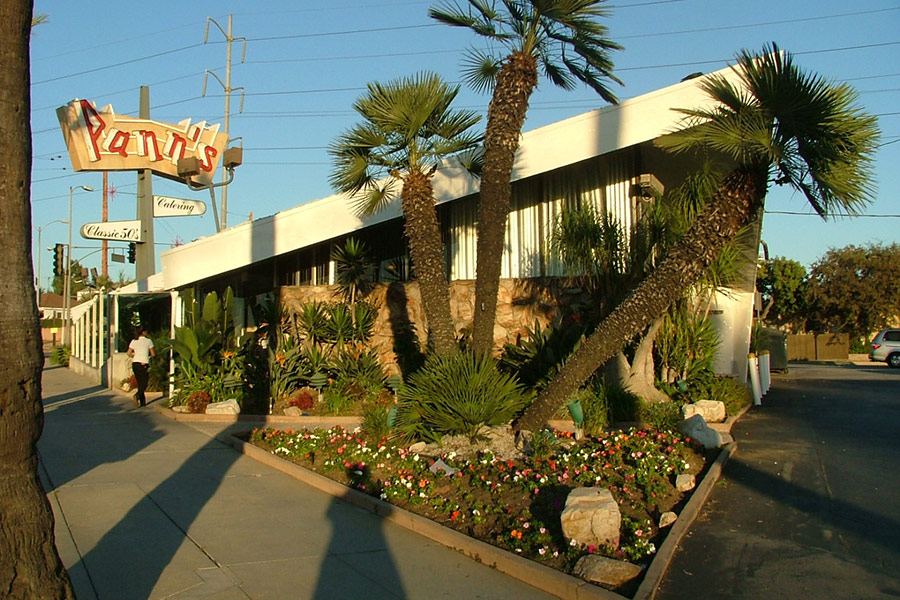
The avalanche of support for Norm’s La Cienega, the Googie Modern coffee shop recently threatened with demolition, exposes an often overlooked fact: Modernism can be popular.
Many early modern architects sought to bring the fruits of the industrial age to the average person. Over time that goal was often blurred as modernism focused on custom homes and skyscrapers. Today modernism has been narrowed to a stripped-down, less-is-more aesthetic of white walls and spare furnishings, but back in the day there were many modernisms—including the vibrant, popular public architecture of Googie coffee shops that began in Los Angeles and spread nationwide.
In midcentury Southern California, the everyday life of the average citizen was filled with modern architecture: supermarkets, gas stations, banks, bowling alleys, drive-through laundries. Leading the list were the exuberant Googie-style coffee shops (not “diners”) that were prominent on the streets of Los Angeles. Besides a half dozen Norm’s by Armet and Davis, there were Tiny Naylor’s and Biff’s by Douglas Honnold, the Wich Stand and Pann’s by Armet and Davis, Ship’s by Martin Stern, Jr. in Westwood and Culver City, Bob’s Big Boys by Wayne McAllister, and many more. They helped define the urban character of the car-centric city. Most have been replaced, and always by buildings designed not nearly as well.
Googie, the name given to this ultramodern roadside style, comes from the name of a 1949 restaurant on the Sunset Strip designed by master architect John Lautner, who studied with Frank Lloyd Wright. It exhibited the hallmarks of the style: outside, a boldly scaled roof to grab the attention of motorists driving by, with a neon sign integrated into the design. Inside, large glass windows gave views of the lively street scene, and the kitchen was open so customers could watch their food being made. True to modern principles, form followed function in Googie design, and the function was to draw in customers in their cars, and feed them in an appealing, exciting modern environment.
In Los Angeles, to be part of the modern age you didn’t need to hire A. Quincy Jones or Ed Killingsworth to build you a Case Study house. For the price of a hamburger and coffee you could step into the modern world, anywhere in the city.
In dozens of examples, Googie was excellent design—modern architects orchestrating modern materials, technology, and lifestyles into thoroughly modern spaces and structures. Step inside Norm’s today and the optimism, the openness, the innovation of its style is still striking. Instead of the traditional box enclosed by four walls, the space is open, defined by glass walls that eliminate the barrier between inside and outside. Slender columns clad with ceramic tiles support the truss roof that sweeps upward to expand the space. Every detail, from the shape of the roof, to the integral neon sign, to the jazzy angles of the tables and banquettes, to the custom-designed stainless steel kitchen counters, grills, pie cabinets, and spring-loaded plate holders, contributes to a unified design. The kinetic shapes, natural textures, landscaping, and warm colors reflect the organic modernism of Frank Lloyd Wright, not the austerity of Bauhaus modernism.
The quality of Googie Modernism is no mystery. Louis Armet and Eldon Davis, the architects of Norm’s and a series of definitive Googie coffee shops, trained at the USC School of Architecture, one of the headwaters of California Modernism.
Yet in spite of this heritage, and its fulfillment of modernism’s quest to serve the average person, Googie has been largely neglected by official histories. “Googie was used as a synonym for undisciplined design and sloppy workmanship,” explained writer Esther McCoy.
Most establishment critics considered Googie the bastard child of modern architecture. Residential and institutional design was respectable; commercial design (especially coffee shops) was not. Googie’s flashy neon, exaggerated forms, and its appeal to the masses disqualified it as serious design. Plus it was from California.
Modernists may have embraced the masses in theory, but the profession’s patrician heritage found popular architecture distasteful.
Paul Rudolph (perhaps with a touch of defensiveness) warned in 1952 about the lack of discipline he detected in Googie. Freedom in design was fine, but needed to be carefully guided. Then “one could unleash the imagination… without fear of producing ‘Googie’ architecture,” he lectured. The modernism heralded by Museum of Modern Art exhibits was elegant, tasteful, subdued. It did not need to shout. Googie did.
So successfully was Googie suppressed that to this day there are academics from the east coast who have never even heard of the term.
But Esther McCoy was right: “Googie was not a name forgotten in a year; it clung to us.” The support for Norm’s La Cienega proves Googie has stood the test of time.
Make no mistake, Googie is as Modern as a Craig Ellwood house. From now on when we think of Los Angeles Modernism, we must think of the public modernism of Googie as well as the private modernism of the Case Study houses. They’re two sides of the same coin.